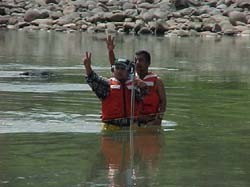
Honduras was not prepared for a major natural disaster like Hurricane Mitch in 1998. Officials were unable to gauge how quickly the rivers were rising from the constant rain, and thus did not know when to take the necessary steps to evacuate people into secure areas. On the other end of the spectrum, droughts are characteristic in parts of Honduras, but residents usually do not become aware of the shrinking rivers until it is too late.
Being able to measure the depth and flow of rivers during both the rainy season and the dry season is vital to the health and well-being of Hondurans. Working with the Ministry of Natural Resources and Environment, USAID helped Honduras construct and implement a hydrological network that will help the government track this information.
Twenty-three telemetric stations were set up throughout the country to measure precipitation and river levels and transmit data to satellites. The information is then posted on the Internet, where engineers, emergency agencies, power plants and communities can access timely and accurate water information — essential to preparing for and mitigating flood and drought disasters. Now that officials can track river levels, they are more able to plan targeted evacuations during heavy rains and help farmers better prepare for droughts during the dry season.







Comment
Make a general inquiry or suggest an improvement.